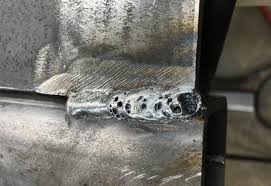How to Recognize What is Porosity in Welding and Improve Your Technique
How to Recognize What is Porosity in Welding and Improve Your Technique
Blog Article
The Scientific Research Behind Porosity: A Comprehensive Overview for Welders and Fabricators
Recognizing the complex systems behind porosity in welding is vital for welders and producers making every effort for remarkable craftsmanship. From the composition of the base products to the details of the welding process itself, a wide range of variables conspire to either aggravate or reduce the existence of porosity.
Comprehending Porosity in Welding
FIRST SENTENCE:
Evaluation of porosity in welding reveals essential insights into the integrity and quality of the weld joint. Porosity, identified by the existence of dental caries or voids within the weld metal, is a typical issue in welding procedures. These gaps, otherwise correctly dealt with, can jeopardize the structural integrity and mechanical residential or commercial properties of the weld, leading to potential failures in the completed product.

To spot and evaluate porosity, non-destructive testing approaches such as ultrasonic testing or X-ray examination are commonly employed. These methods permit the recognition of inner problems without compromising the honesty of the weld. By examining the dimension, shape, and circulation of porosity within a weld, welders can make educated decisions to enhance their welding processes and accomplish sounder weld joints.

Variables Affecting Porosity Formation
The incident of porosity in welding is affected by a myriad of elements, varying from gas securing effectiveness to the ins and outs of welding parameter settings. One critical variable adding to porosity formation is insufficient gas shielding. When the shielding gas, usually argon or carbon dioxide, is not properly covering the weld pool, atmospheric gases like oxygen and nitrogen can contaminate the liquified metal, bring about porosity. In addition, the tidiness of the base materials plays a significant function. Impurities such as corrosion, oil, or dampness can vaporize during welding, creating gas pockets within the weld. Welding parameters, consisting of voltage, present, travel speed, and electrode type, additionally influence porosity formation. Using incorrect setups can generate too much spatter or warm input, which in turn can cause porosity. Moreover, the welding method utilized, such as gas steel arc welding (GMAW) or protected steel arc welding (SMAW), can influence porosity formation as a result of variants in warmth circulation and gas protection. Recognizing and controlling these elements are essential for lessening porosity in welding procedures.
Impacts of Porosity on Weld High Quality
The existence of porosity also compromises the weld's resistance to rust, as the entraped air or gases within the gaps can respond with the surrounding atmosphere, leading to destruction over time. Additionally, porosity can hinder the weld's capability to withstand pressure or effect, further jeopardizing the total top quality and dependability of the bonded framework. In critical applications such as aerospace, automobile, or structural buildings, where safety and sturdiness are critical, the harmful effects of porosity on weld top quality can have extreme effects, highlighting the significance of reducing porosity via appropriate welding techniques and procedures.
Techniques to Minimize Porosity
To boost the top quality of bonded joints and guarantee architectural honesty, welders and makers utilize certain strategies aimed at reducing the formation of spaces and tooth use this link cavities within the material during the welding process. One efficient method to lessen porosity is to make sure appropriate product prep work. This consists of extensive cleansing of the base metal to eliminate any type of pollutants such as oil, oil, or wetness that could add to porosity formation. Additionally, making use of the suitable welding parameters, such as the appropriate voltage, present, and take a trip speed, is vital in avoiding porosity. Maintaining a consistent arc size and angle during welding likewise helps in reducing the likelihood of porosity.

Furthermore, picking the best shielding gas and keeping proper gas flow rates are essential in reducing porosity. Using the ideal welding technique, such as back-stepping or utilizing a weaving motion, can also assist distribute heat evenly and decrease the chances of porosity development. Making sure appropriate air flow in the welding environment to eliminate any potential sources of contamination is vital for achieving porosity-free welds. By implementing these techniques, welders can effectively reduce porosity and generate top notch welded joints.

Advanced Solutions for Porosity Control
Executing sophisticated innovations and cutting-edge methods plays a critical role in attaining exceptional control over porosity in welding procedures. In addition, employing innovative welding methods such as pulsed MIG welding or customized atmosphere welding can additionally help mitigate porosity problems.
One more innovative remedy entails using sophisticated welding tools. Utilizing devices with integrated attributes like waveform control and innovative power resources can improve weld high quality and reduce porosity dangers. The execution of automated welding systems with precise control over parameters can significantly minimize porosity defects.
In addition, including advanced tracking and assessment modern technologies such as real-time X-ray imaging or great post to read automated ultrasonic testing can help in finding porosity early in the welding procedure, enabling for prompt corrective activities. In general, integrating his response these advanced services can significantly boost porosity control and enhance the general top quality of welded parts.
Verdict
To conclude, comprehending the scientific research behind porosity in welding is necessary for welders and producers to create high-quality welds. By identifying the elements influencing porosity formation and applying techniques to minimize it, welders can enhance the overall weld quality. Advanced services for porosity control can better boost the welding procedure and guarantee a strong and trustworthy weld. It is essential for welders to continuously educate themselves on porosity and implement ideal practices to accomplish optimum outcomes.
Report this page